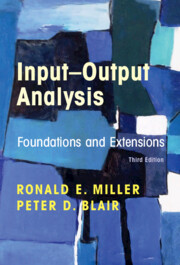Book contents
- Input–Output Analysis
- Input–Output Analysis
- Copyright page
- Contents
- Figures
- Tables
- Preface
- 1 Introduction and Overview
- 2 Foundations of Input–Output Analysis
- 3 Input–Output Models at the Regional Level
- 4 Organization of Basic Data for Input–Output Models
- 5 The Commodity-by-Industry Approach in Input–Output Models
- 6 Multipliers in the Input–Output Model
- 7 Supply-Side Models, Linkages, and Important Coefficients
- 8 Decomposition Approaches
- 9 Nonsurvey and Partial-Survey Methods:
- 10 Nonsurvey and Partial-Survey Methods:
- 11 Social Accounting Matrices
- 12 Energy Input–Output Analysis
- 13 Environmental Input–Output Analysis
- 14 Mixed and Dynamic Models
- 15 Additional Topics
- Postscript
- Book part
- Author Index
- Subject Index
- References
14 - Mixed and Dynamic Models
Published online by Cambridge University Press: 06 January 2022
- Input–Output Analysis
- Input–Output Analysis
- Copyright page
- Contents
- Figures
- Tables
- Preface
- 1 Introduction and Overview
- 2 Foundations of Input–Output Analysis
- 3 Input–Output Models at the Regional Level
- 4 Organization of Basic Data for Input–Output Models
- 5 The Commodity-by-Industry Approach in Input–Output Models
- 6 Multipliers in the Input–Output Model
- 7 Supply-Side Models, Linkages, and Important Coefficients
- 8 Decomposition Approaches
- 9 Nonsurvey and Partial-Survey Methods:
- 10 Nonsurvey and Partial-Survey Methods:
- 11 Social Accounting Matrices
- 12 Energy Input–Output Analysis
- 13 Environmental Input–Output Analysis
- 14 Mixed and Dynamic Models
- 15 Additional Topics
- Postscript
- Book part
- Author Index
- Subject Index
- References
Summary
Chapter 14 describes so called mixed input–output models that are driven by a mix of output and final demand specifications rather than driven either solely by specification by final demand or total output. This chapter also introduces dynamic input–output models that more explicitly capture the role of capital investment and utilization in the production process.
Keywords
- Type
- Chapter
- Information
- Input-Output AnalysisFoundations and Extensions, pp. 678 - 721Publisher: Cambridge University PressPrint publication year: 2022
References
- 1
- Cited by

